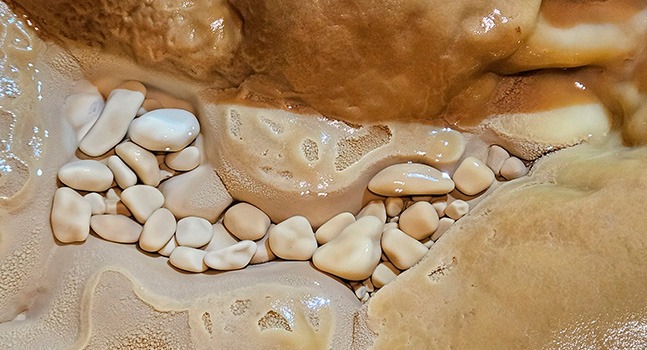3 de April de 2025
A new research led by Geosciences Barcelona (GEO3BCN-CSIC) will study the impact of climate change on karst cavities and caves in the Orígenes Geopark of the UNESCO Geoparks network, and it is located at the Tremp Basin, in the northwest of Spain (Lleida). Scientists will focus especially on cave pearls, calcareous concretions, also known as pisolites or oolites, with a rounded appearance, which can be formed by the action of water on the ground, in landings, wall niches or at the bottom of galleries.
“Cavern pearls are a type of speleothem growth; very little is known about them,’ explains Mercè Cisneros, researcher at GEO3BCN and head of the project. ‘They are rare deposits, difficult to find and still poorly studied, unlike stalagmites or stalactites, which have been widely studied’.
The research seeks to understand how rising temperatures and reduced precipitation in the Catalan Pyrenees can alter the hydrogeological balance of the caves, which has therefore effects on the formation of cave pearls. Pearls are very sensitive to water changes and can provide information about environmental changes in the cave where they have grown, in a similar way to stalagmites.
Understanding their formation and growth
Cavern pearls grow when thin layers of calcite accumulate around a core that is partially or fully submerged in water. When examined internally, a succession of concentric rings can be seen, reminiscent of tree rings. Interpreting them remains a challenge for researchers.
Based on their external morphology—such as shape, texture, or visible features—it is possible to infer whether the dripping rate was faster or slower, or whether the puddle where the pearls grew contained more or less water. “How long does it take for a pearl to grow? ‘An ongoing study at our centre suggests an annual growth of tens of micrometres in cavern pearls from Sima Montserrat Ubach, Solsonès [a region in Catalonia],’ says Mercè Cisneros. ‘However, growth rates vary depending on numerous factors.’
Previous studies have detected annual growth of a few tens of micrometres in cavern pearls from Mediterranean areas. However, in southern China, growth rates as low as one micrometre per year have also been recorded in cavern pearls dating back to the Late Pleistocene, more than 10,000 years ago. The thickness of the laminae may depend on the drip rate and water availability, but also on the chemical composition of the incoming water.
“This is certainly a little-explored topic, and we have not yet dated the growth in pearls from the Orígenes Geopark,” says Cisneros. She admits that “we still don’t fully understand what the pearls can reveal to us.” It is necessary to date the pearls, to correlate their growth with the climatic conditions of the caves, the quantity of pearls formed, the geological conditions and external environment…
As a point of interest, Cisneros brings up one of the few studies dedicated to cave pearls, in which pearl dating helped establish the age of some mammoth remains from the Late Pleistocene. The fossils were found in Diaozhongyan Cave (China), and by dating cavern pearls found in the same sediments, researchers were able to determine the maximum age of the fossil remains.
“We know that caves, in general, are becoming drier,” says Cisneros. In this sense, “cave pearls could act as sentinels of caves’ vulnerability to climate change,” since a decrease in water caused by longer dry spells can stop their growth and alter the internal conditions of the caves. Preliminary observations already indicate a drying trend inside the caves, which could have significant consequences for biodiversity and the conservation of underground heritage.
Moreover, compared to other habitats and ecosystems, subterranean ecosystems are still largely unknown. We don’t know much about the fauna, but we know even less about the flora and micro-organisms (such as bacteria and fungi) found in caves, many of which may be or have been present in the pearls. Since calcite precipitation in some pearls is induced by microbiota, they could be said to be linked to biodiversity.
Geopark Orígenes, a natural park in the Tremp Basin of Lleida, with its diversity of landscapes and climatic patterns, is an ideal place for this type of research. According to Cisneros, the ‘heterogeneous weather patterns’ in this area make it possible to analyse how different conditions affect cavities and pearl formation.
Projections can also be made to anticipate increased variability in rainfall and more intense droughts. In this sense, the study will also help predict groundwater availability. The project, coordinated by the Geociències Barcelona institute, will study 15 caves in the natural park. The analysis of cave pearls will be carried out in the institute’s laboratories using techniques such as X-ray diffraction, X-ray fluorescence, Raman spectroscopy, and scanning electron microscopy.
Additionally, the project promotes the involvement of the local community, including speleologists and local administrations. One of the initiatives will be a call for volunteers to contribute old pictures of the caves, which would allow researchers to compare the evolution of cave pearls over time.
The researcher also highlights the logistical challenges of the study: “Some of the caves are very difficult to access, such as the Graller del Boixaguer cave, which is 148 metres deep.” For this reason, scientists will have the support of the Montain’s Friends Society (SAM, by its Spanish acronym). This project will contribute not only to scientific knowledge but also to the preservation of the natural and cultural heritage of the Orígenes Geopark, in the context of climate change, which is already affecting the subterranean depths of the Catalan Pyrenees.
Written by CSIC Catalunya and GEO3BCN Communications departments

